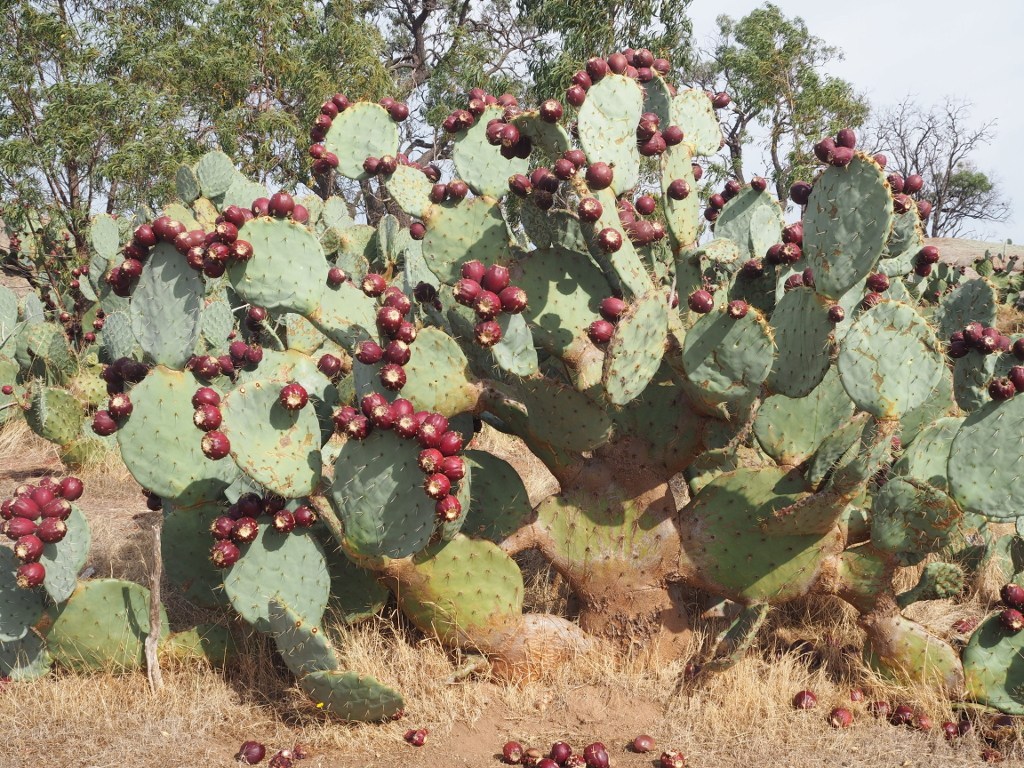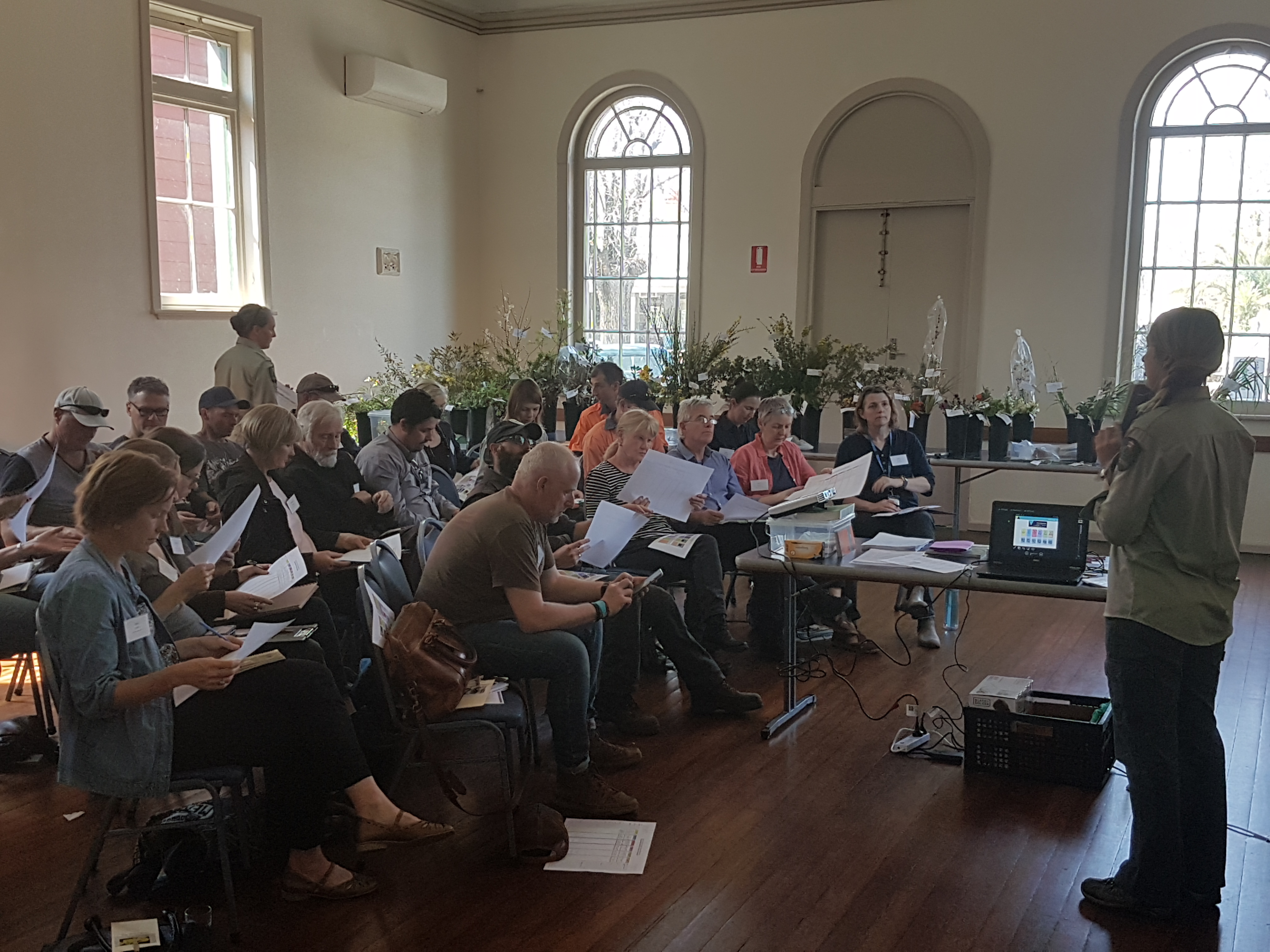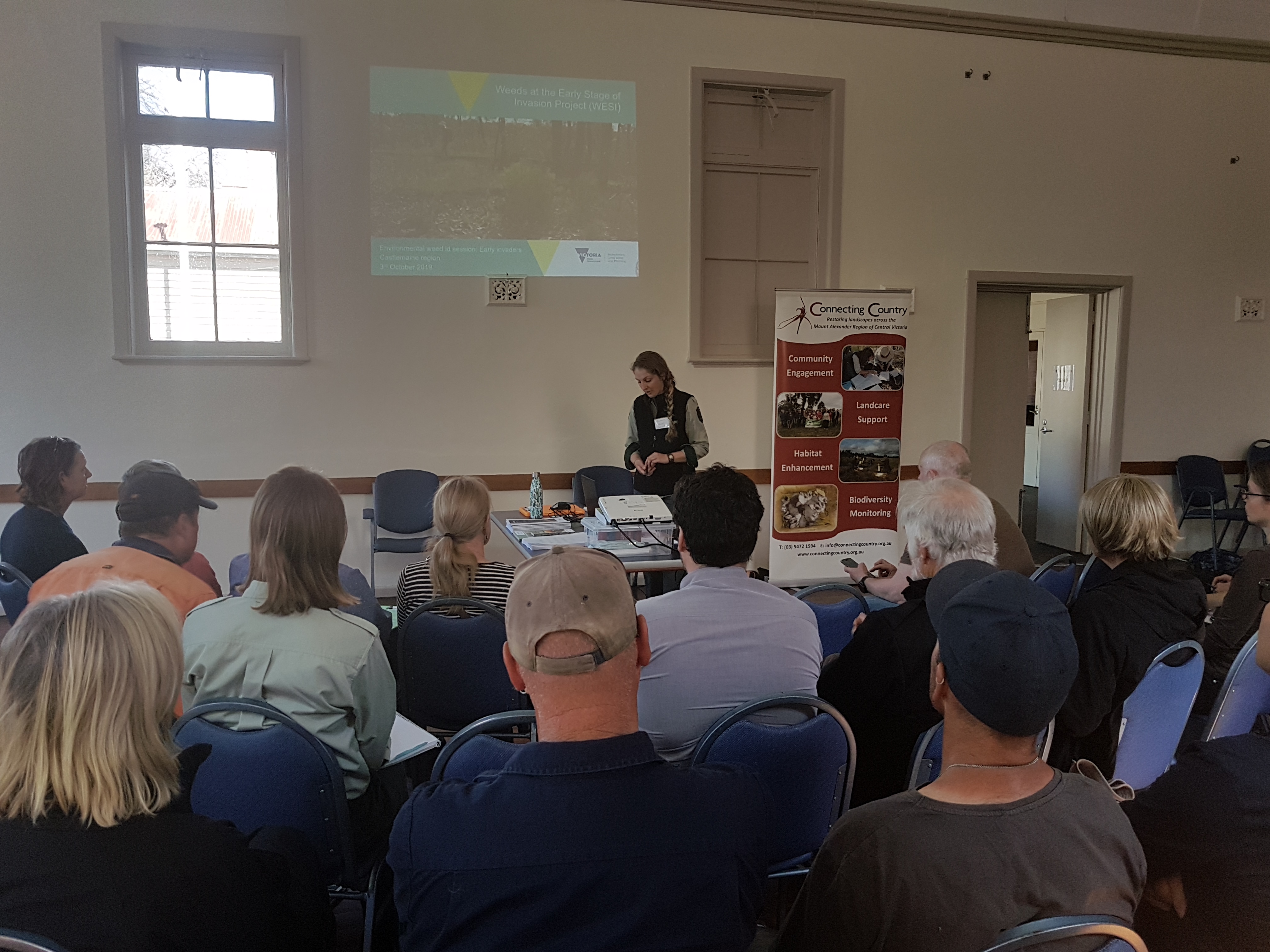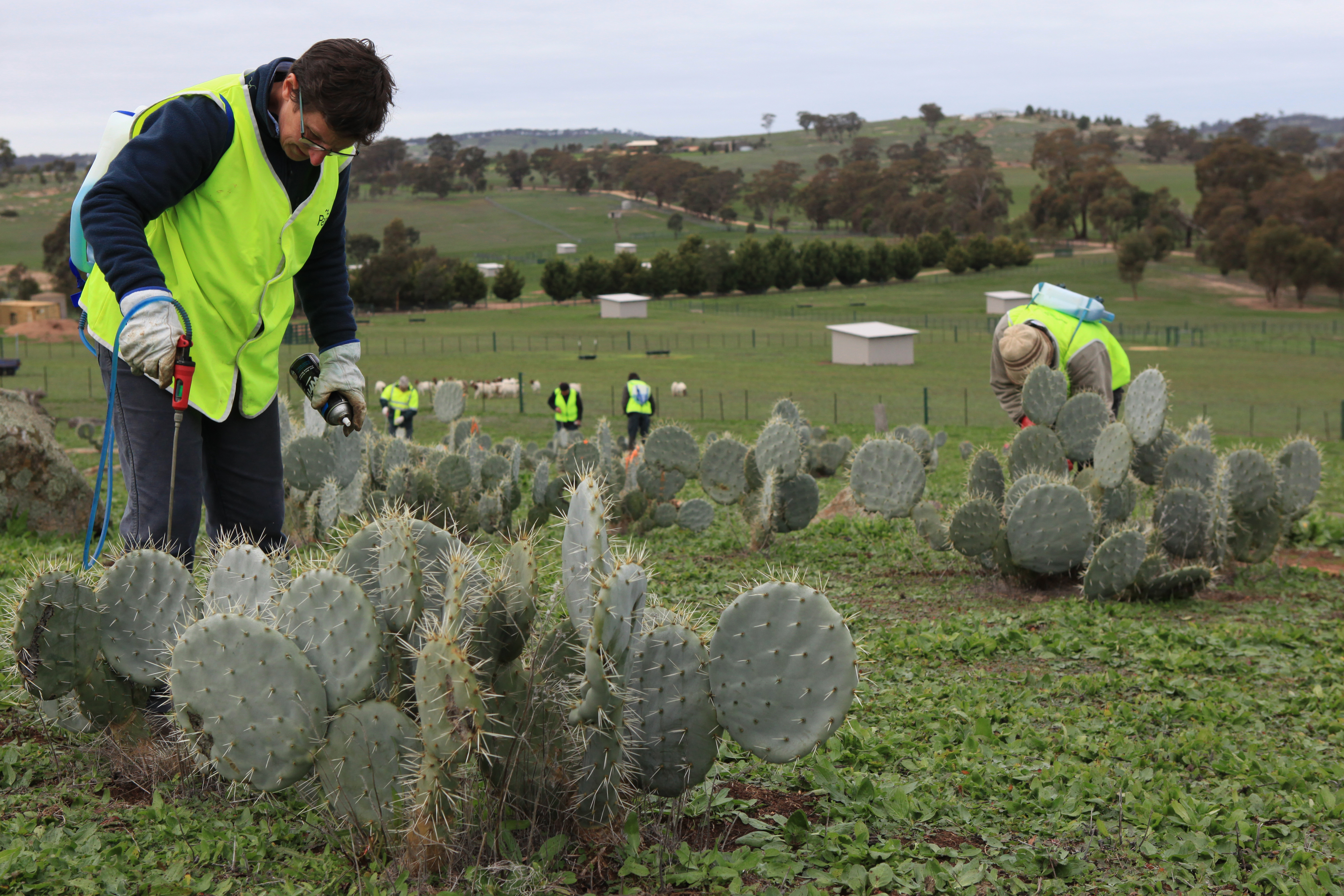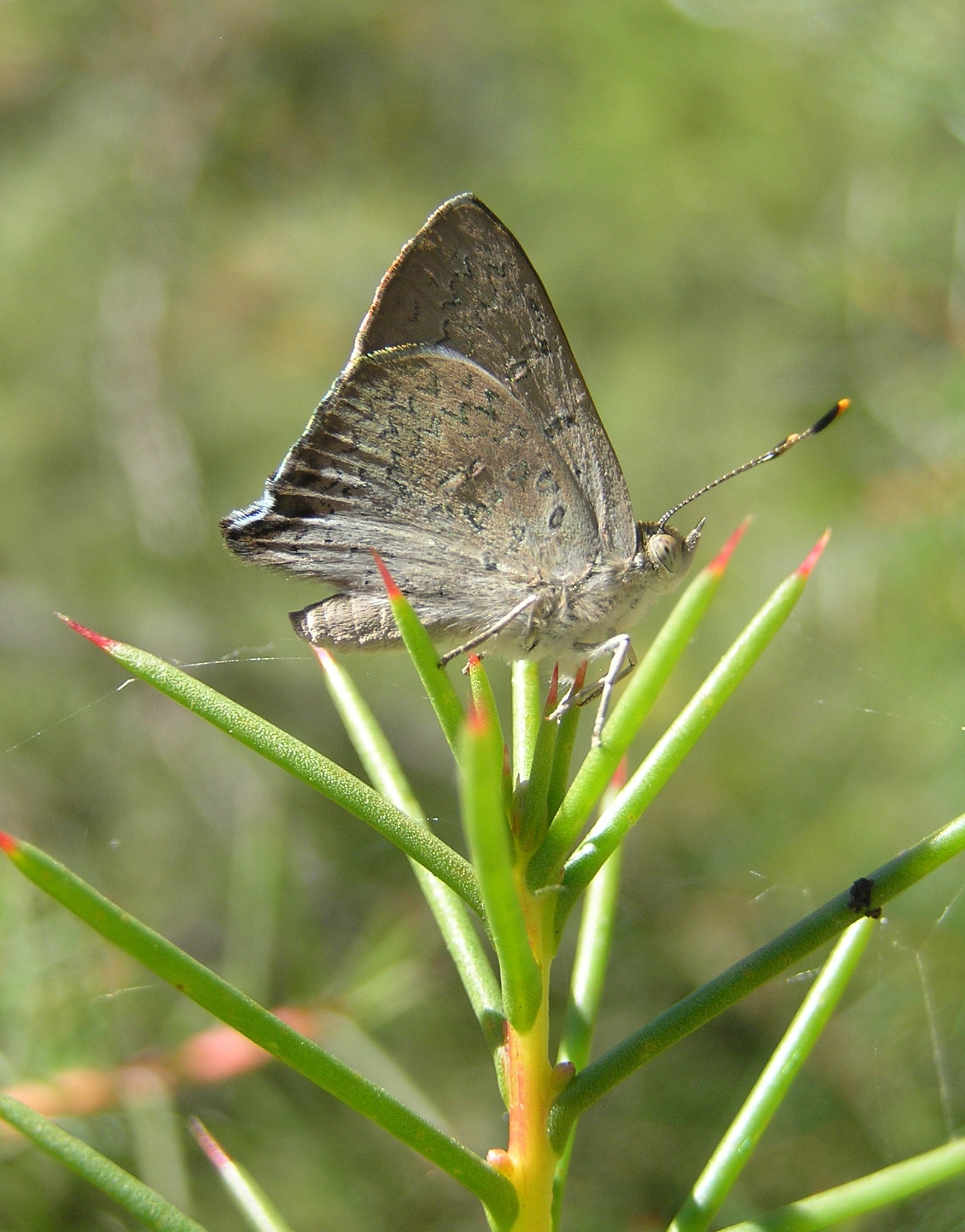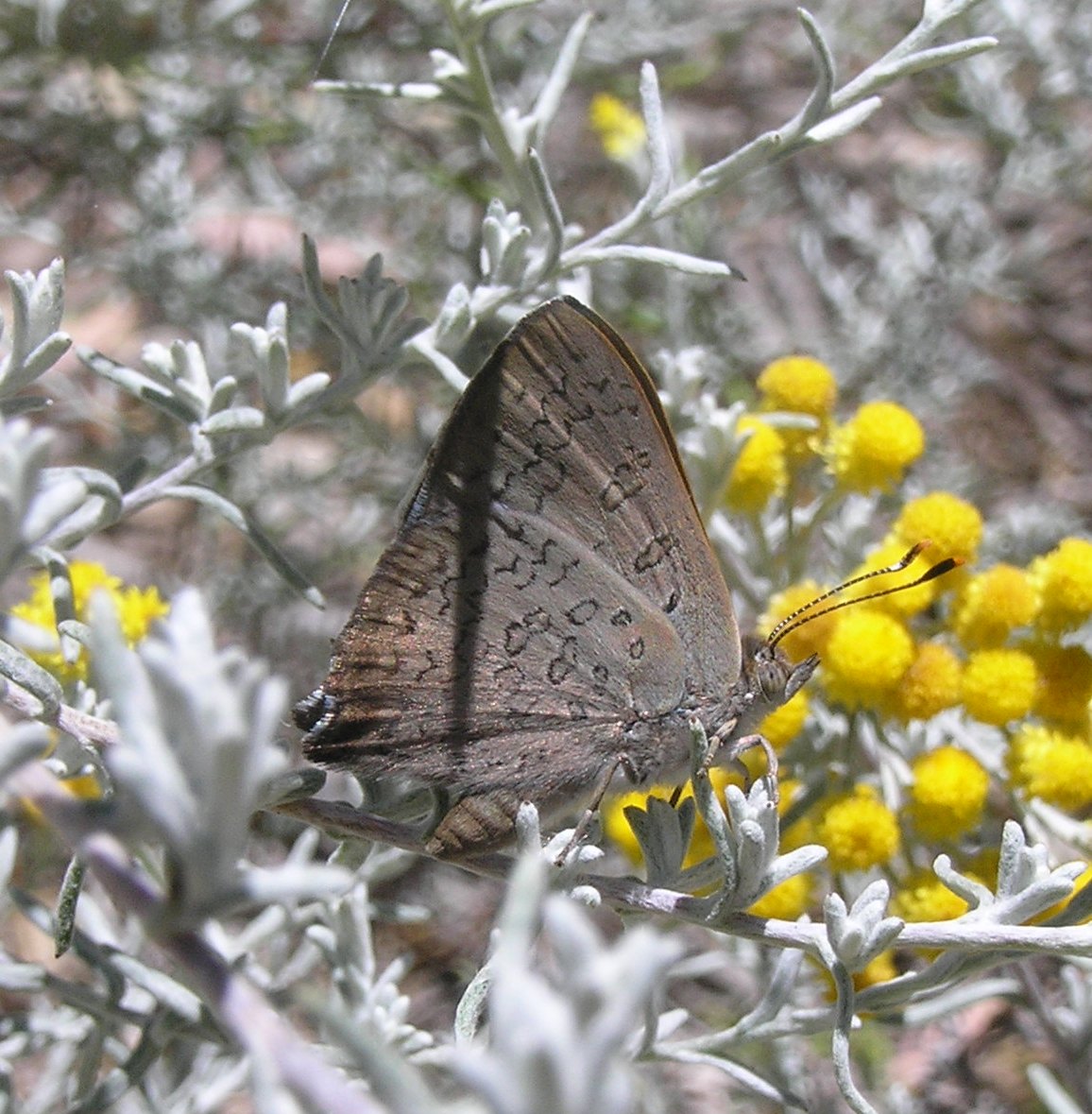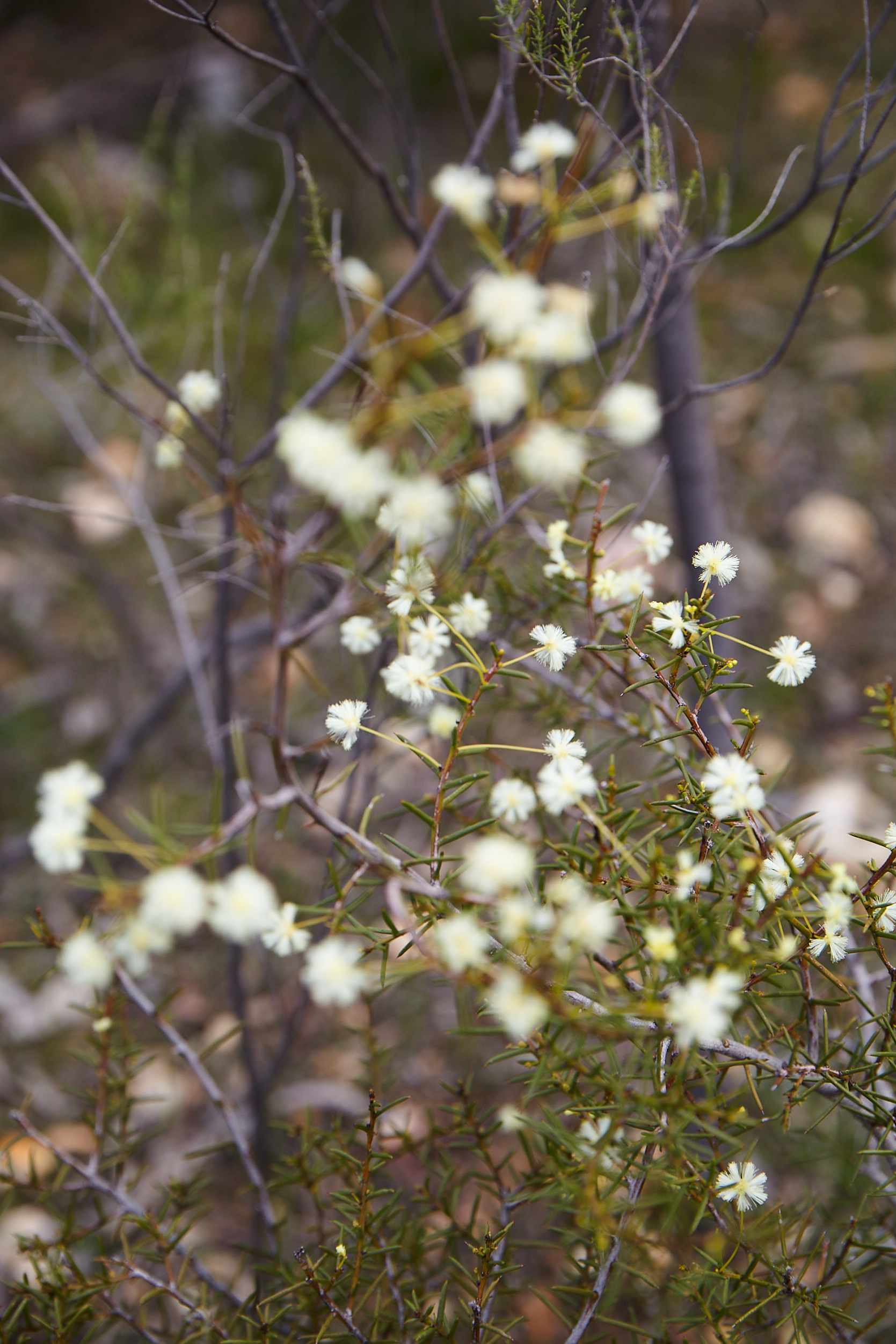Cactus Warriors AGM and Plains-Wanderer talk: 24 November 2019
Posted on 20 November, 2019 by Ivan
Our partners, the Tarrangower Cactus Control Group, are holding their Annual General Meeting along with a talk on the critically endangered, fascinating Plains-Wanderer bird. Here are further details provided by the Cactus Warriors.
The Cactus Warriors have, yet again, had a very rewarding year destroying many thousands of Wheel Cactus plants in our local environment and increasing awareness about this noxious weed in our community. The Tarrangower Cactus Control Group would like to thank the many landowners and volunteers for their dedicated work and wonderful results.
The Cactus Warriors are holding an end of year celebration to reward our ‘warriors’, including an exciting presentation and free lunch. The guest speaker, committee member Bec James, is a Natural Environment Program Officer with the Department Environment, Land, Water and planning, and Secretary of the Victorian Weed Society. And for something completely different, Bec will present about the project she’s currently working on to help save the critically endangered Plains-Wanderer bird in Northern Victoria.
We invite all past, present and future ‘cactus warriors’ to join us at 11:30 am on Sunday 24 November 2019 to hear our special guest speaker, followed by a delicious lunch. No RSVP is required. Please join us in the Band Room, Maldon Community Centre, 6 Francis St, Maldon VIC. We’ll have a very quick AGM at 11.00 am, before the presentation, which everyone is also welcome to attend.
For more information about Wheel Cactus, and how to control this invasive species, please watch the video below from the Cactus Warriors.
Exploring the colour of wildflowers (and the joy of surprises)
Posted on 19 November, 2019 by Ivan
Getting out and about reminds us of just how many lovely wildflowers and things there are happening in the bush, even as the weather warms up! We are blessed to live in a region with large tracts of public land with woodland wonders aplenty, and now is a great time to get out and see some of the vivid and subtle colors our bushland has to offer. One of our Landscape Restoration Coordinators, Bonnie Humphreys, has kindly outlined some of the native species that may still be flowering and on show over the next few weeks, including a few surprises below!
- Bush Peas (Pultenaea sp.) and Parrot Peas (Dillwynia sp.) are flowering.
- Silver Wattle (Acacia dealbata) is laden with pods at the moment, hinting at a good year for seed production.
- Black Wattle (Acacia mearnsii) is in flower with lemony yellow blooms. Some can be seen from the Forest Creek bridge on Duke St, on the right hand side as you head towards Chewton.
- Chocolate Lilies (Arthropodium strictum) and Sticky Everlastings (Xerochrysum viscosum) are looking spectacular.
- Look out for beautiful white flowers from Sweet Bursaria (Bursaria spinosa) and White Marianth (Rhytidosporum procumbens).
- Creamy Candles (Stackhousia monogyna) are flowering. These have a lovely perfume which is most prevalent at night indicating a preference for night pollinator such as moths.
- Cats Claw Grevillea or Alpine Grevillea (Grevillea alpina), some plants are still flowering away. There are many different colour forms in this plant including green, yellow, red, and then mixes of combinations.
There are many great places for bushwalking on public land in our region, including Kalimna Park (just a short walk from Castlemaine town centre), Rise and Shine Bushland Reserve (Sandon), Monk Track in the Dry Diggings National Park (Chewton), Muckleford State Forest, and Guildford Bushland Reserve. View excellent ground-truthed maps of many of these areas by local cartographer Jase Haysom by clicking here. Local bird expert Damian Kelly’s book Castlemaine Bird Walks is another great resource for bird and wildlife outings in the bush.
Before the heat takes the color and vibrancy out of these treasures, be sure to explore some of the abundant nature hotspots in our region. Scroll down to see pictures below of some colourful characters from our local bush.

Chocolate Lilies (Arthropodium strictum) and Sticky Everlastings (Xerochrysum viscosum). Photo: Bonnie Humphreys

Muckleford bush with Parrot Pea (Dillwyina sp.), Cats Claw Grevillea (Grevillea alpina), Murnong or Yam Daisy (Microseris walteri), Grey Everlasting (Ozothamnus obcordatus) and Chocolate Lilies (Arthropodium strictum). Photo: Bonnie Humphreys

Keep an eye out for nesting birds. Here’s an Owlet Nightjar fledgling checking out the world! Photo: Bonnie Humphreys
‘Hearing our place’ with Andrew Skeoch and AGM 2019 – BOOK NOW!
Posted on 13 November, 2019 by Ivan
We would like to remind our valued Connecting Country members and the wider community to book now for our 2019 Annual General Meeting this weekend. Our very special guest, Andrew Skeoch, will speak about ‘Hearing our place’ in nature.
Frances Howe, Connecting Country Director, says ‘Andrew Skeoch is an educator, naturalist, environmental thinker and one of Australia’s best-known nature sound recordists. From his bush home near Newstead, he has journeyed over the last 25 years to remote locations in Asia, India, America, Europe, Africa and the Pacific in search of some of our planet’s most beautiful and fascinating sounds.
Combining this field experience with a deep curiosity, Andrew explores the crucial role of sound and communication in nature and evolution. He weaves the latest scientific understandings into a fascinating celebration of the natural soundscape around us.
His intriguing presentation will focus on our box ironbark birdsong and natural soundscapes, and will have you appreciating our local bushlands from an entirely fresh perspective.’
The AGM will include a brief presentation from staff and committee members about Connecting Country’s achievements over the last decade, to allow supporters old and new to hear what Connecting Country does and our plans for the coming year.
This free event is at 4.00 – 6.00 pm on Saturday 16 November 2019 at Campbells Creek Community Centre (45 Elizabeth St, Campbells Creek VIC).
Afternoon tea will be provided from 3.30 pm.
Please RSVP online (click here) by 13 November 2019 for catering purposes. If you have any questions, please email asha@connectingcountry.org.au or call (03) 5472 1594.
Click here to download the flier.
Click here to download a committee nomination form.
Click here to download a membership application.
Eltham Copper Butterfly talk in Castlemaine – Friday 8 November 2019
Posted on 7 November, 2019 by Frances
Castlemaine and Bendigo host the largest known area of Eltham Copper Butterfly (ECB) habitat in the world. Given the global decline in insects, it is critical that we protect our Australian species such as the endangered Eltham Copper Butterfly.
Local ecologists Elaine Bayes and Karl Just are guest speakers at the November meeting of the Castlemaine Field Naturalists Club. They will discuss the current distribution of ECB, the amazing relationship ECB has with Notoncus ants and the host plant Sweet Bursaria, and the local butterfly monitoring program. There has been little research on the central Victorian populations of ECB over the last decade. Elaine, Karl, and Julie Radford are trying to change this by leading the community in searching for new ECB populations and mapping colonies so we can protect them from planned burns and other threats.

The beauty of the Eltham Copper Butterfly (photo by Elaine Bayes)
Upcoming opportunities for the local community to be involved in studying and saving this species will be provided. Monitoring ECB also provides a great excuse to walk through our stunning bushlands over the summer months when ECB are flying and mating.
The monthly Castlemaine Field Naturalists Club meeting will start at 7.30 pm on 8 November 2019. This month the meeting will be held in the chapel behind the Uniting Church on Lyttleton St, Castlemaine VIC (next door to the Castlemaine Art Museum). All members are all encouraged to attend and, as always, visitors are also very welcome. There is no cost for entry and no need for bookings.
If you are interested in helping Karl and Elaine with the monitoring of this amazing local butterfly over November and December 2019, please click here
Platypus survey in Campbells Creek
Posted on 7 November, 2019 by Ivan
Our partners and good friends at Friends of Campbells Creek Landcare Group have arranged for the Australian Platypus Conservancy (APC) to conduct a Platypus survey at six locations along Campbells Creek, Victoria, in mid-November 2019.
The survey has been funded by Coliban Water. The survey will commence on the evening of Friday 15 November 2019 (depending on appropriate weather conditions), and finish early on Saturday morning. The APC team will be based at the Campbells Creek Community Centre. The first inspection of the nets will be at around 10 pm and continue throughout the night, approximately every two hours.
On Saturday morning at around 7.30 am, the results of the survey will be discussed at the Campbells Creek Community Centre (45 Elizabeth St, Campbells Creek VIC). Interested community members are welcome to join in and see the results. Tea and coffee will be available. In 2020 the APC team will return to conduct a citizen science workshop to present information on the biology and conservation considerations of Platypus and Rakali (native water rat), followed by a practical session on Campbells Creek. We will keep you informed of this event.
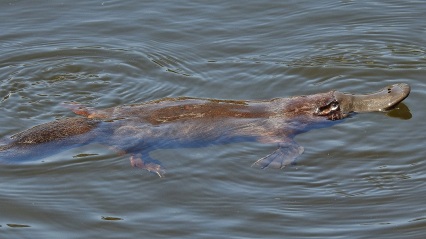
The platypus has a streamlined body and a superficially duck-like bill (photo: APC)
For more information about Friends of Campbells Creek Landcare Group and the Platypus project, please click here.
For more information about the Australian Platypus Conservancy (APC) and the survey methods, please click here.
Free disposal of Wheel Cactus at Maldon Transfer Station
Posted on 30 October, 2019 by Ivan
Here is an update from the Tarrangower Cactus Control Group regarding the disposal of the invasive plant Wheel Catcus (Opuntia robusta) in the Mount Alexander region of central Victoria.
Thanks to renewed funding from Mount Alexander Shire Council, Wheel Cactus plants can again be disposed of FREE at the Maldon Transfer Station. This is a great incentive to dig up Wheel Cactus plants while they’re still small and before they’ve started producing fruit and seeds. Hopefully it will also encourage everyone to remove any outlying plants they see starting to grow in new areas.
Small Wheel Cacti are really easy to dig up because they are very shallow-rooted plants. To help, digging hoes and buckets can be borrowed from the Tarrangower Cactus Control Group. Digging up small plants also reduces the need for the chemical herbicides required when plants are left to grow to maturity.
Alas, there is a limit of one trailer load per property each financial year, because the funding is limited and Wheel Cactus infestations are so widespread across so many properties. However, if you do have more Wheel Cactus plants you’d like to dig up, an alternative solution is to dig a big hole on your property, and dump and bury the weeds on site (also saving you the time, effort and cost of carting to the tip).
What is Wheel Cactus?
A plant native to Mexico, this cactus (Opuntia robusta) is most commonly called Wheel Cactus in Australia. It was probably introduced into our country as a hardy garden plant. This cactus species has a distinct blue-green colour and large, flat, round pads with many short and long spines. The plant is erect and can grow to 3 m tall. It has yellow flowers and dark red fruit in spring-summer, each containing approximately 500 seeds that are spread by animals and water.
This weed is widely established in central Victoria, western New South Wales, and south-eastern and eastern South Australia. It particularly likes to grow on granite outcrops, but also infests woodlands and pastures.
For more information on Wheel Cactus and how to control this invasive species, please click here
Seek and discover
Posted on 30 October, 2019 by Ivan
Have you ever wondered what that mysterious plant might be and don’t have the knowledge or time to consult with a botanical encyclopedia? Meet Seek!
The Seek app is an online social network for nature enthusiasts and is part of an ongoing attempt to involve ordinary people in citizen science projects. Similar to Shazam – an app that allows you to identify music from audio recordings – the Seek app allows you to identify plants and animals from your photos by harnessing image recognition technology. It is still in the early stages of learning many of the native species from this region, but learns from each experience it is exposed to.

The Seek app enables you to take photos of nature and have complex articifical intelligence attempt to identify them. Photo: I-Naturalist
The beauty of this app is that it encourages curious adventurers to become engaged with the wildlife around them. Fun and educational for kids and adults alike, users can earn badges while they learn about each new species they photograph.
We tried this app around Castlemaine in central Victoria to identify plants (and chickens in the community garden adjacent to our office – red jungle fowl, tick!), and found its ability to identify plants depended on the camera’s ability to focus. Moving the camera around at different angles (without taking a photo), helped it recognise exotic plants to genus level. It performed better at identifying exotic species, which is useful if you want to identify weeds. At this point in Seek’s development, it didn’t succeed at identifying any plants to species level. We recommend patience and a good field guide, as we found the app incorrectly identified an Early Black Wattle (Acacia decurrens – native to NSW and a weedy invader of bushland in central Victoria), as Silver Wattle (Acacia dealbata), (Acacia dealbata – a locally indigenous species.
With further development, this could be a powerful app for anyone learning to identify weeds and local native species, and also for recording observations in the landscape. Seek draws from existing data collected from wildlife observations on iNaturalist, in combination with artificial intelligence and neural network technologies. Once downloaded, users are provided with lists of commonly recorded plants, insects, birds and other animals in their area. When a new photo is uploaded, the app’s artificial intelligence analyses the photo to find a match, adds it to the user’s collection, and provides a summary of information from Wikipedia.
![]()
The app software currently recognises 30,000 species, and will continue to improve with further use. The app’s co-founder Scott Loarie explains, ‘The only way we can improve our modeling of species is to get more data, and to do that we need more people outside taking pictures’.
The Seek app doesn’t require any registration to use and doesn’t collect any user data by default, though location data is used to show you the plants and animals in your area. Alternatviely, if an app is not for you, you might be interested to have a look at the Flora of Australia website
You can read more about the Seek app, and to download it for free – click here.
October Wheel Cactus Community Field Day – 27 October 2019
Posted on 24 October, 2019 by Ivan
Tarrangower Cactus Control Group and Parks Victoria will hold their next Community Field Day on Sunday 27 October 2019, with the group keen to get some new Cactus Warriors on board.
- Where: Treloars Rd, Tarrangower, VIC. Follow the signs along Watersons Rd.
- When: 10.30 am to 12.30 pm on Sunday 27 October 2019.
Come and join the Cactus Warriors and Parks Victoria for a morning in the fresh air and learn how best to destroy Wheel Cactus. The location is at a property in Treloars Rd, around the corner from Watersons Rd. The route will be well signposted. The morning’s activities finish with a delicious BBQ lunch and friendly chat. The event is family friendly but children must be accompanied by a parent at all times.
For more information on the infamous Cactus Warriors – click here.
Check out the poster below for a location map or visit www.cactuswarriors.org and subscribe for a monthly field day reminder.
Connecting Country’s new factsheets for landholders
Posted on 24 October, 2019 by Ivan
Landholders and managers now have access to four new factsheets from Connecting Country. The factsheets are tailored to suit the needs of the Mount Alexander region of central Victoria, and include local information about invasive species management and creating habitat for our unique biodiversity.
The four factsheets clear and practical information about:
- Weed control.
- Nestboxes for wildlife.
- Invasive pest animals.
- Revegetation planting with tubestock.
The advantage of these factsheets is they were developed and produced specifically for our region’s landscape, biodiversity and local conditions. They cover invasive animals that you are likely to see in this region and give an overview of the landowner responsibilities for invasive animals and plants. Managing invasive species is an important step to restoring our local habitat and biodiversity. Invasive species was listed as the number two threat for threatened species, with only habitat loss having a larger impact on our threatened species.
These factsheets were made possible by funding from the North Central Catchment Management Authority, as part of our project called ‘Prickly plants for wildlife on small properties’. Through this project we’ve helped numerous local landholders with smaller areas of remnant vegetation to protect and improve habitat on their land. We’ve supported landholders with on-ground actions such as revegetation planting, weed and rabbit control, and nestbox installation, as well as delivering three popular community education events.
A lot of people contact Connecting Country regarding how to best revegetate the landscape using native species in tubestock. There are many factors to consider when using this technique, such as when to plant, how to prepare the soil, what to plant, and how to protect your plantings. The new revegetation planting factsheet covers all these topics and more to help you give your precious native plants the best start in life.
To view the four factsheets – click here

Following best practice will give your tubestock planting the best chance of long-term success (photo by Ivan Carter)
Aussie Backyard Bird Count: 21-27 October 2019
Posted on 17 October, 2019 by Ivan
There’s only one week to go until the Aussie Backyard Bird Count begins. Have you registered yet?
By participating in the Aussie Backyard Bird Count, you will be helping BirdLife Australia find out about the birds that live where people live. This is especially important because even common bird species are strong indicators of the health of the environment. Think of birds as a barometer for nature.
And if that’s not incentive enough, there are some exciting prizes on offer. With thanks to our generous supporters, you could win — a pair of Swarovski binoculars, a copy of ‘Thirteen Ways to Look at Birds’ or a Gang-gang Cockatoo pin badge. Simply submit a bird count to BirdLife from 21-27 October 2019 to be in the running!
If you have any questions about the Aussie Backyard Bird Count, please head to the FAQ page below, where you’ll find information about registering, participating and troubleshooting.
Get ready to count!
Community trained in early invaders
Posted on 9 October, 2019 by Ivan
The Weeds at the Early Stage of Invasion (WESI) Project, together with Connecting Country, had a strong turnout for their training event last Thursday 3 October 2019 in Newstead VIC. The education event, part of our Habitat Health Check project, focused on identifying environmental weeds that are not yet established in our region, but have the potential to grow their distribution.
The session targeted identification of some early-invader environmental weeds relevant to the Mount Alexander region, including Asparagus fern (Asparagus scandens), White Spanish Broom (Cytisus multiflorus), Broad kernel Espartillo (Achnatherum caudata), Dropping Tree-Pear (Opuntia monacantha), Buffel Grass (Cenchrus ciliaris) and Old Man’s Beard (Clematis vitalba).
Early invaders are plants that have naturalised and started to spread. When spread has just begun, such plants are localised and generally encountered only by chance. Coordinated management intervention (i.e., eradication or containment) is feasible at this stage, due to their highly restricted distributions.
The training did an excellent job in alerting all attendees to the threats of many common garden varieties that can escape under the right conditions and impact surrounding landscapes. All 30 participants learned how to identify these plants, how to record and photograph them, and how to treat and survey the area.
The session also provided samples of another 25 plants that are invasive plants in our region, with attendees getting a chance to get up close and personal to the specimens and learn how to identify them from look-a-likes. Kate Blood and Bianca Gold, from the WESI-DEWLP team, showed passion and precision throughout the day and enlightened all who attended in the emerging threats to the regions biodiversity and agriculture. It was heartening to see attendees from the Mount Alexander Shire Council, Coliban Water, Parks Victoria, Landmate, North Central Catchment Management Authority, and many Landcare and community groups from across our region.
The WESI Project focuses on high risk invasive species at the early stage of invasion that threaten biodiversity. The WESI project works mainly with Department of Environment, Land, Water and Planning (DELWP) and Parks Victoria staff looking after public land and biodiversity across Victoria, but also trains community groups and landowners in identifying early invaders.
For more information on the WESI training, please click here. If you would like to be involved in Connecting Country’s monitoring program, please click here.
Here are some photos from the training by Ivan Carter (Connecting Country) and Kate Blood (DELWP).
Friends of the Box-Ironbark Forests PhotoShow – Now Open Togs Cafe
Posted on 26 September, 2019 by Ivan
One of Connecting Country’s closest collaborators, Friends of the Box-Ironbark Forests (FOBIF), has a photographic show that is now open at Togs Cafe in Lyttleton Street, Castlemaine, Victoria. It will run till 24 October 2019 and features a stunning array of local photographers. All photos are for sale with proceeds going to FOBIF.
Since 1999, the Friends of the Box-Ironbark Forests have been conducting art and photography exhibitions with this being their tenth exhibition since 2009. Six of these have been at Togs Cafe. They have all had the same purpose: to honor the native forests of the region, continuing the long tradition of artistic involvement with these forests. Photographers in this exhibition are all local residents, and talented ones at that.
Connecting Country would like to thank all the photographers who contributed photos to this project.
You can download a catalogue with a brief description of each photo here.
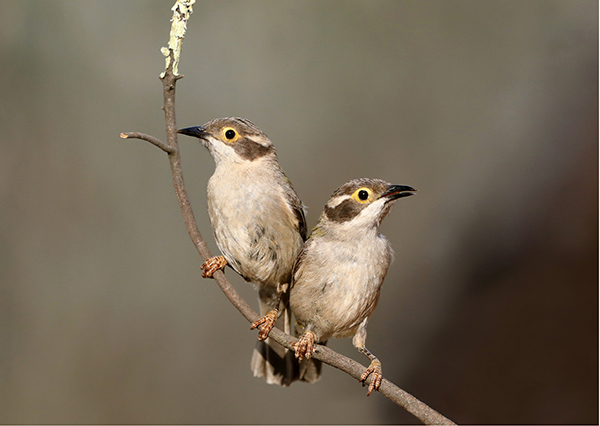
One of the photos from the show: Brown-headed Honeyeater (Lichenostomus melithreptus) Photo: Patrick Kavanagh 2019
Cactus Warriors Wanted – Sunday 29 September 2019
Posted on 26 September, 2019 by Ivan
The Tarrangower Cactus Control Group (TCCG) and Parks Victoria will hold their next community field day this Sunday to the west of the Maldon township, Victoria, Australia. This event is open to everyone in the community and is a great way to learn more about the threats posed by Wheel Cactus and do something about the spread across our region.
Come along, enjoy the fresh air, destroy some cactus and then join the community for a free cuppa and sausage sizzle.
Where: 200 Treloars Road, Tarrengower VIC (follow the signs along Watersons Road)
When: 10.30 am to 12.30 pm, Sunday 29th September 2019
The Tarrangower Cactus Control Group Inc. (TCCG) consists of Landcare volunteers dedicated to the eradication of Wheel Cactus (Opuntia robusta). TCCG, in conjunction with Parks Victoria, holds friendly and informal Wheel Cactus Control community field days to inform and demonstrate control techniques, on the last Sunday of the month from May to October. These field days always end with a free BBQ lunch, cuppa and cake and the opportunity to chat, exchange ideas and make contacts.
It is a great opportunity to spend a rewarding morning outdoors, meeting neighbours and others who are concerned about preserving our unique environment. Everyone is welcome, no previous experience is required and all equipment is supplied. View the video to catch the ‘cactus warriors’ in action.
Weeds at the Early Stage of Invasion – Thursday 3 October 2019
Posted on 17 September, 2019 by Ivan
The Weeds at the Early Stage of Invasion (WESI) Project, together with Connecting Country, invite you to join us for a session on identifying environmental weeds.
When: Thursday 3 October 2019 from 10.00 am to 3.00 pm
Where: Newstead Community Centre, 9 Lyons St, Newstead, VIC
To register: click here
To download the event flyer: click here
The session will focus on identification of some early invader environmental weeds relevant to the Mount Alexander region. The WESI Project focuses on high risk invasive species at the early stage of invasion (early invaders) that threaten biodiversity. The WESI project works mainly with Department of Environment, Land, Water and Planning (DELWP) and Parks Victoria staff looking after public land and biodiversity across Victoria.
This training is targeted at community groups, individuals, organisations and land managers. Come along to learn how to identify these plants, how to record and photograph them, and how to treat and survey the area. Early invaders are plants that have naturalised and started to spread. When spread has just begun, such plants are localised and generally encountered only by chance. Coordinated management intervention (i.e., eradication or containment) is feasible at this stage, due to their highly restricted distributions.
This is a free event with morning tea and lunch provided.
Spaces are limited so please register below asap to ensure you don’t miss out!
For more information please contact Bianca Gold and Kate Blood (WESI Project), or Ivan Carter (Connecting Country):
- Kate Blood (0417 135 356 or kate.blood@delwp.vic.gov.au)
- Bianca Gold (0436 694 971 or bianca.gold@delwp.vic.gov.au)
- Ivan Carter (5472 1594 or ivan@connectingcountry.org.au)

Chilean needle grass was once an emerging weed in this region, but is now established around Taradale (photo by Connecting Country)
Meet Castlemaine’s endangered butterfly – Saturday 12 October 2019
Posted on 17 September, 2019 by Ivan
Did you know Central Victoria is home to the largest known population of the endangered Eltham Copper Butterfly in the world?!
Enjoy these beautiful pictures of the Eltham Copper Butterfly taken by Elaine Bayes.
Tim Low’s challenging ‘New Nature’ talk in Newstead
Posted on 17 September, 2019 by Ivan
Connecting Country and Newstead Landcare Group recently hosted a presentation by well-known author and biological scientist Tim Low. Tim attracted a packed room of 200 excited people to Newstead VIC. He guided us through some highlights from his recently revised book ‘The New Nature’, exploring the concepts of winners and losers in a world of human impact, changing climate and declining resources.
Tim said the attendance was one of the best he had been involved with and interest from the audience was outstanding. Tim described some surprising examples of how conservation and urbanisation can co-exist in some situations. A theme from the talk was that the conservation movement often talks about declining species, as it should, but this leaves many people unaware that some animals and plants are doing better today than ever before, because they have found ways to exploit us.
The ‘New Nature’ book reinforces the concept that animals don’t have any concept of ‘natural’ or ‘unnatural’ so they don’t automatically recoil from cities and farms. Sometimes they can do better in cities than in forests, and Tim suggested that Australian cities and towns are gaining animals over time. The audience was surprised to hear that Melbourne, Sydney and Brisbane are now home for peregrine falcons that nest on skyscrapers, and feed off pigeons and other city-dwelling birds. After the talk Tim took questions from the audience. He stressed that while we will have some winners from our changing planet, we must continue to work hard to prevent losing more species to extinction through habitat loss.
Many thanks to Frances Cincotta and Newstead Landcare Group for helping organise this event and doing some fantastic work. The event was supported by funding from North Central Catchment Management Authority as part of Connecting Country’s ‘Prickly Plants for Wildlife on Small Properties’ project, as well as a donation from Friends of the Box-Ironbark Forests.
Although the event was not recorded, there is link to a similar talk on Youtube below.

Tim Low (second from left) with Frances Howe, Frances Cincotta and Ivan Carter (photo by Connecting Country)
 Tim Low
Tim Low
Tim Low is a biologist and best-selling author of seven books about nature and conservation. ‘Where Song Began’ won several prizes, including the Australian Book Industry Award for best general non-fiction. It was praised in the New York Review of Books and recommended by Scientific American. ‘The New Nature’ was praised by Time magazine and listed by Who magazine as one of the books of the year. ‘Feral Future’ inspired the formation of a conservation group, the Invasive Species Council. Tim’s articles have appeared in Australian Geographic, The Weekend Australian Magazine, The Guardian and many other places. He works partly as an environmental consultant, and has a lizard named after him. He recently returned from a visit to Manchuria as a guest of the China Writer’s Association.
You can read more about Tim Low and view his Blog and website – click here
Spring railway walk with Nuggetty Land Protection Group – 22 September 2019
Posted on 11 September, 2019 by Jess
Nuggetty Land Protection Group is planning a walk along the Nuggetty to Shelbourne Railway line. This was a branch line from Maldon through Nuggetty and Bradford and ends at the Shelbourne Station complex. The old railway line traverses farmland and Bradford Nature Conservation Reserve. The line was closed in 1960 after due to major fire damage. There will be a stop for lunch at the reserve to look at local birds, orchids and other flora. Binoculars, tea, coffee and water will be available.
Spring railway walk
When: Sunday 22 September 2019 from 9:30 am
Where: Park at Nuggetty Peace Monument, Nuggetty School Rd, Nuggetty VIC (turn right off Shelbourne Rd north of Maldon). A community bus will transport walkers to start of walk.
Bookings preferred: Jane Mitchell (0457 729 132) or Christine Fitzgerald (0419 347 408)
The walk is approximately 13 km. Bus will meet at intersections of roads if lift required and return you to your car or take you to next section of the walk. Please bring own lunch and water, and wear walking shoes, weather appropriate clothing and hats. The event will be cancelled if weather inclement. Please leave pets at home.
Castlemaine BirdLife walk at Pilchers Bridge – 7 September 2019
Posted on 5 September, 2019 by Ivan
Fancy a lovely walk through the Pilchers Bridge Nature Conservation Reserve (near Sutton Grange), led by local enthusiasts Jenny Rolland and Euan Moore? Please see the monthly Birdlife Castlemaine walk details below, from their e-newsletter.
Saturday 7 September 2019 at Pilchers Bridge Nature Conservation Reserve
Join us for a spring-time walk in the beautiful Pilchers Bridge Nature Conservation Reserve, led by Jenny Rolland and Euan Moore. We will walk down Andrews Track through mixed box forest to the dam where we will sit and watch the birds as we have a morning tea break (a small mat would be useful for sitting on by the dam). Then we will walk eastwards along Andrews Track (undulating), head north off-track and return to Andrews Track along the creek lines. The terrain here will be open and relatively flat but the ground could be uneven. We will then walk back up the hill to the cars. This walk is based on a walk from Damian Kelly’s ‘Castlemaine Bird Walks’ book (page 75).
We should see several honeyeater and thornbill species, Treecreepers, Scarlet Robin, Rufous Whistler, Grey Fantail, Crimson Rosella, and if we are lucky, Speckled Warbler and Hooded Robin.
All ages and levels of experience welcome. This is an easy walk covering approx 3 km, finishing at around midday. Please note there are no toilets at the Reserve.
Location and directions: From Harcourt, travel southeast along the old Calder Highway (Harmony Way) for about 6 km and turn left along Faraday-Sutton Grange Road. After about 9 km, turn left along the Bendigo-Sutton Grange Road and after about 7 km turn right into Huddle Road (unsealed). After about 1.5 km, look for a small unsealed track on the right – Andrews Track. Park at this junction or at the lay-by about 50 m before the junction. If you reach the sealed road, you have gone too far.
Time: Meet at the junction of Huddle Road and Andrews Track in the Pilchers Bridge Nature Conservation Reserve at 8:45 am, or to carpool from Castlemaine meet at 8:00 am outside Castlemaine Community House (formerly Continuing Ed), Templeton Street, Castlemaine VIC.
Important information about walks: Bring water, snacks, binoculars, hat, sunscreen, sturdy shoes, long pants during snake season, and other weather-appropriate gear.
Walks will be cancelled if the temperature is forecast to be 35 degrees or more during the walk period, severe weather warnings are forecast, and/or if the day has been declared a Total Fire Ban.
Questions? If you have questions about BirdLife Castlemaine’s walks program, you can email at castlemaine@birdlife.org.au, or call Judy Hopley (0425 768 559) or Asha Bannon (0418 428 721).
Reminder: talk by renowned author Tim Low on Friday 6 September 2019
Posted on 29 August, 2019 by Ivan
Don’t miss out on a chance to spend the evening with a renowned author who wrote the first nature book ever to win the Australian Book Industry Awards prize for best General Non Fiction! Tim Low will talk in Newstead VIC on Friday 6 September 2019 at 7.30 pm.
Connecting Country and Newstead Landcare Group are delighted to host Tim, who will speak on his book ‘The New Nature’. Although controversial when first published in 2002, the book was recently updated and its themes are now more relevant than ever. Following Tim’s presentation there will be an opportunity for questions and answers, then a cuppa and cake.
Tim Low talk on ‘The New Nature’
When: 7.30 pm on Friday 6 September 2019
Where: Newstead Community Centre, Lyons St (Pyrenees Hwy) Newstead, VIC
All welcome. A gold coin donation will help us cover costs. Bookings not required.
For our event flyer – click here
This event is supported by funding from North Central Catchment Management Authority and Friends of the Box-Ironbark Forests.
 Tim Low
Tim Low
Tim Low is a biologist and best-selling author of seven books about nature and conservation. ‘Where Song Began’ won several prizes, including the Australian Book Industry Award for best general non-fiction. It was praised in the New York Review of Books and recommended by Scientific American. ‘The New Nature’ was praised by Time magazine and listed by Who magazine as one of the books of the year. ‘Feral Future’ inspired the formation of a conservation group, the Invasive Species Council. Tim’s articles have appeared in Australian Geographic, The Weekend Australian Magazine, The Guardian and many other places. He works partly as an environmental consultant, and has a lizard named after him. He recently returned from a visit to Manchuria as a guest of the China Writer’s Association.
‘The New Nature’
The conservation movement talks about declining species, as it should, but this leaves many people unaware that some animals and plants are doing better today than ever before, because they have found ways to exploit us. Australia has winners as well as losers. Animals don’t have any concept of ‘natural’ or ‘unnatural’ so they don’t automatically recoil from cities and farms. Sometimes they can do better in cities than in forests – Australian cities and towns are gaining animals over time. Melbourne, Sydney and Brisbane now have peregrine falcons nesting on skyscrapers. Some urbanising species, notably corellas and flying foxes, are becoming sources of conflicts that need careful consideration. The notion of wilderness can get in the way of understanding all this because it implies that nature is authentic only when there is no human influence. But animals and plants have been benefiting from humans ever since Aboriginal people began burning the ‘wilderness’ to manage it.
You can read more about Tim Low and view his blog and website – click here
Wattle walk and talk well received
Posted on 29 August, 2019 by Ivan
The wattles were blooming like crazy for the strong crowd of nearly 50 people at our ‘Wonderful World of Wattles’ event on Saturday 24 August at Campbells Creek in central Victoria. It was a day to remember, with sunny weather and two excellent guest speakers to educate participants about the beauty, benefits and biodiversity of the Acacia (wattle) species in our region. Connecting Country, Friends of Campbells Creek Landcare and Friends of the Box-Ironbark Forests partnered to deliver the event, which was part of our larger ‘Prickly plants for wildlife’ project funded through the North Central Catchment Management Authority.
The event kicked off indoors with retired academic and botanist Rod Orr, who has spent many years volunteering at the Bendigo Field Naturalists Club. Rod provided an excellent overview on the ecology and biological function of wattles. The audience was fascinated to learn that wattles can produce their own nitrogen fertiliser through nodules in their roots, allowing them to live in extremely low-nutrient soils. This explains why they are so useful in colonizing disturbed sites and degraded landscapes, like central Victoria!
The second part of the educational event was a walk and talk with Campbells Creek identity Ian Higgins, through the Campbells Creek Reserve at the end of Honeycomb Road. This site proved perfect for the keen audience to test their skills in identifying the large array of Acacia species that had been re-established at the site. Ian pointed out some of the finer skills in how to differentiate between species. He also gave the group a lesson in growing Acacias from seeds, and managed to get the audience to complete some direct seeding in a site dominated by Phalaris grass!
For those who could not attend, Friends of the Box-Ironbark Forests have developed an excellent 112 page book for sale, suited to beginners. In plain language, and generously illustrated, it presents 21 Acacia species that flourish in the Mount Alexander region of central Victoria. A general introduction explains different features of wattles, helping in identification and appreciation of these tenacious and beautiful plants.
Many thanks to Gen Kay, who generously volunteered her photography skills to capture the following images on the day.








